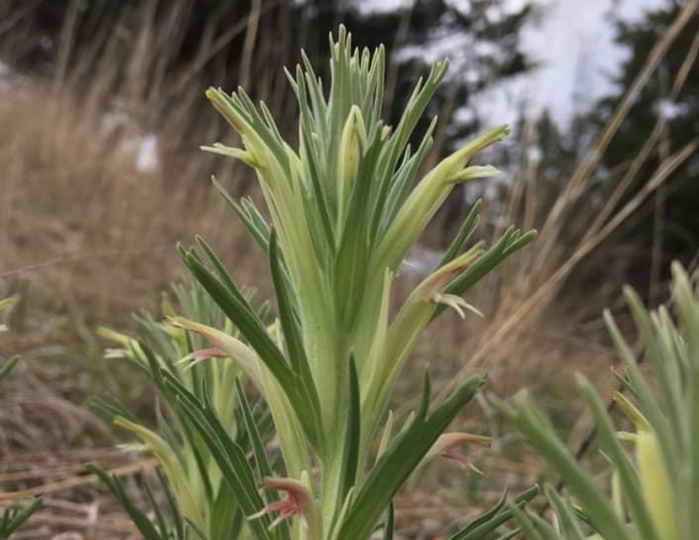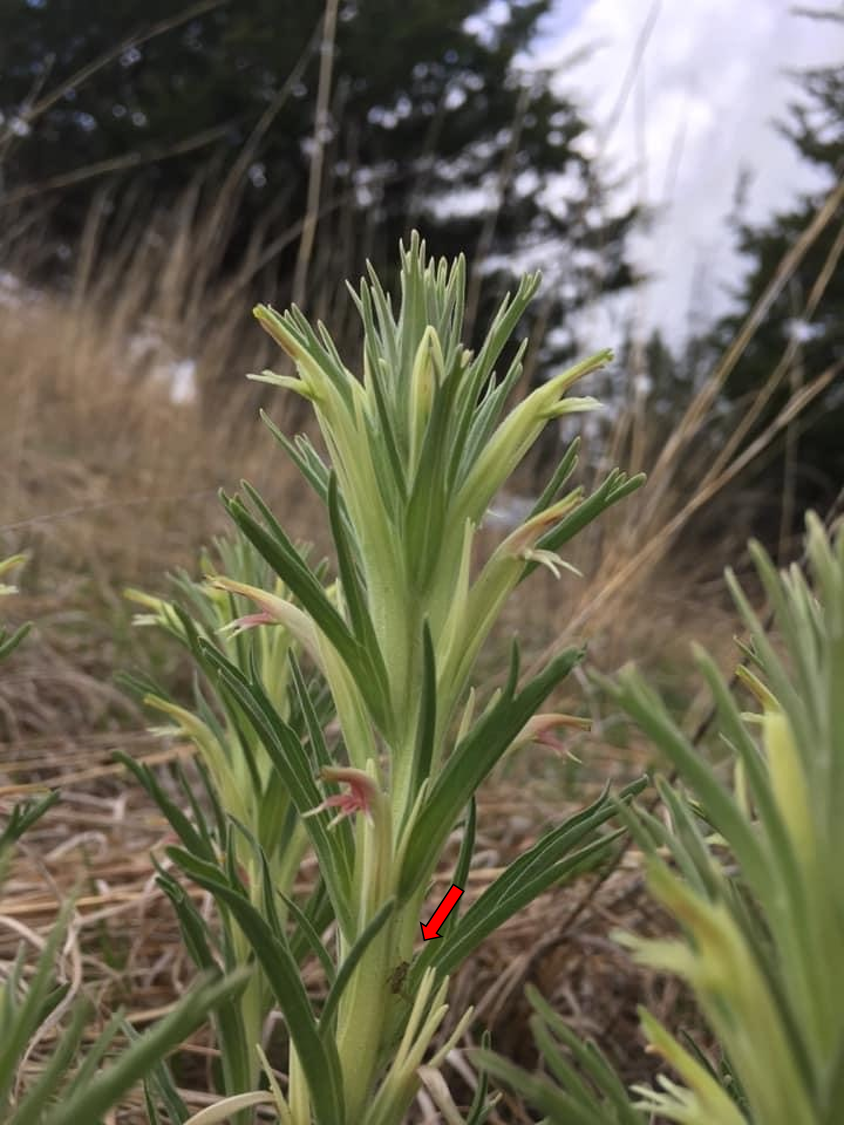Patrick Swanson features an unusual plant growing on the Harrison County prairie he is restoring. -promoted by Laura Belin
Here we are in late spring. Seeing the prairie flowers begin their parade of blooms this year has been providing me with much needed mental respite from the travails of enduring the fallout of the coronavirus pandemic. The resilience of spring flowers in the face of an ever-changing environment, and their interdependence with pollinators offer good reminders of what we should aspire to in ourselves.
Speaking of interdependence, last year I posted an essay describing the lifestyle of a late-summer blooming hemiparasitic plant found on my Loess Hills prairie called Slenderleaf false foxglove (Agalinis tenuifolia).
This year, I thought I would use my first Wildflower Wednesday post to describe another curious hemiparasitic plant living on my prairie, the almost ghostly pale-green Downy Yellow Painted Cup (Castilleja sessiliflora). Its other common names include yellow Indian paintbrush or downy paintbrush.

This perennial plant, which begins to flower on my prairie in early to mid-May, is a member of the Broomrape family (Orobanchaceae), like Slenderleaf false foxglove.
The plant generally has one to several leafy, simple stems ranging from 4 to 14 inches in height emerging from a woody root crown.
Minnesota Wildflowers further describes downy yellow painted cup as follows:
Flowers are in a dense, leafy spike along the upper half of the stem. Individual flowers are about 1 inch long, pale yellow to greenish, tubular with a long slender upper lip and a shorter lower lip, lobed in 3 parts. […]
Leaves are 1 to 3 inches long, narrow with rounded tips or narrowly lobed in 3 parts, softly hairy, toothless, with no leaf stalk. Stems are densely hairy and unbranched, though a plant typically has multiple stems.
Though broadly distributed throughout the Great Plains, downy yellow painted cup in Iowa is mostly restricted to the bluff lands in the northeastern part of the state, and drier sites in the prairies and Loess Hills of north-central and north-western Iowa. Notably, it is listed as endangered in Illinois.
The host range of this plant includes various grasses, such as grama and June grasses, and, at least in Wisconsin, Castilleja sessiliflora is known to parasitize eastern redcedar (Crosswhite and Crosswhite 1970). In the latter case, plants were not found growing any further than about eight feet from a redcedar.
I have sideoats grama (Bouteloua curtipendula), June grass (Koeleria macrantha), and redcedars growing on my prairie. Some of the painted cups were or are somewhat close to growing cedars, as the example below shows, while I find others growing near leadplant, so I am unsure what might be serving as the host plants for C. sessiliflora on my prairie. However, I am now more cognizant to the possibility that I may need to leave a few cedars standing in the event the Painted Cups are parasitizing them.
The long, slightly curved, tubular flowers are not well-suited to generalist pollinators. In fact, I have learned that this plant seems to rely on a relatively restricted set of pollinators, the identity of which remains at best incompletely understood and still an active area of discovery.
I didn’t appreciate this fact very much when I first discovered C. sessiliflora growing on my prairie, but upon reflection, I have come to realize that I have never seen any insect actively pollinating it. I aim to be more diligent in trying to record these events in the future if I see them.
In Wisconsin, Crosswhite and Crosswhite (1970) reported that C. sessiliflora growing in their limestone goat prairies were pollinated by one species of bumblebee, Bombus fervidus (Golden Northern Bumblebee). That’s it.
It wasn’t until 2013 when another pollinator was identified. Dr. Krissa Skogen’s group at the Chicago Botanic Garden documented downy yellow painted cup growing in Illinois and Colorado being visited by at least one hawkmoth species, Hyles lineata (white-lined sphinx) (Fant et. al. 2013). She has a camera trap photo of one visiting a C. sessiliflora plant on her website.
More recently, at the Ecological Society of America meeting in 2017, Katie Wenzell presented results of studies correlating floral traits in C. sessiliflora with pollinator visitation. The study had some fascinating findings and conclusions reported in the abstract:
At the eastern range extent, hawkmoths were observed to be the most common visitor to flowers, which were white in color, with long, narrow corolla tubes. To the west, both hawkmoths and large and medium-sized bees were common visitors, and plants displayed pale pink flowers with shorter, wider corolla tubes. Because white flowers and long floral tubes are associated with moth pollination and shorter, wider corollas may allow access to shorter-tongued pollinators such as bees, these results lend support to the role of differing pollinator assemblages in shaping floral traits across wide geographic scales. While more detailed pollination data are needed, these results demonstrate clear variation in floral traits, which may relate to variation in locally important pollinators. Such geographic variation in pollinator-mediated selection may contribute to the maintenance of floral polymorphisms in C. sessiliflora.
Based on this observation and the long narrow corolla tubes on the painted cup plants on my prairie, I would speculate that hawkmoths might be a common pollinator. I hope to confirm that using camera traps in the coming years.
While that may indeed be the case, I would like to offer an intriguing new insect visitor that may either be pollinating the flower or possibly robbing it. I base this on two photographs I have taken over the years, the first of which may have inadvertently caught the culprit, and another of a predator who may be waiting for it.
As you can see from the first photo, a small green bee is hovering close the flower. In the second, I snapped a photo of a species of crab spider lurking on the stem of a blooming C. sessiliflora. This crab spider is too small to take on a large bumblebee or hawkmoth, but should be able to nab an unsuspecting small bee. Coincidence? I guess I will have to continue watching these flowers to observe these interactions and keep my camera handy!
Downy yellow painted cup with hovering green bee:
With crab spider:
A closer view of the crab spider:

I hope this story inspires a bit of wonder at what we know and have yet to learn about our native plants.
References:
Crosswhite, F.S. and Crosswhite, C.D. 1970. Pollination of Castilleja sessiliflora in southern Wisconsin. Bulletin of the Torrey Botanical Club 97:100–105.
Fant, J.B., Weinber-Wolf, H., Tank, D.C., and Skogen, K.A. 2013. Characterization of microsatellite loci in Castilleja sessiliflora and transferability to 24 Castilleja species (Orobanchaceae). Applications in Plant Sciences 1(6): 1200564





1 Comment
Very interesting words and photos
Thank you, Patrick Swanson, for providing this informative post, and even more for the work you are doing to restore your prairie.
For whatever it’s worth, I asked a couple of botanist friends about the cedars because I was interested in that question, and both felt the cedars could probably be cut down without causing the painted cups to disappear. But maybe there is more recent research that could be checked.
PrairieFan Mon 1 Jun 1:36 PM